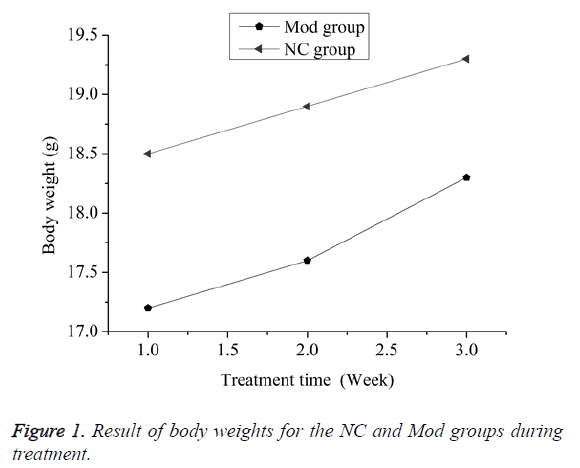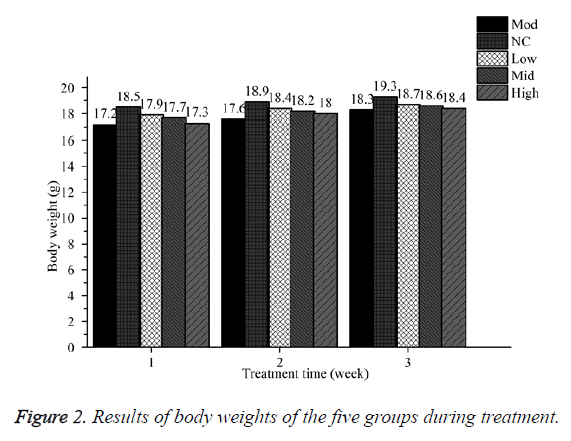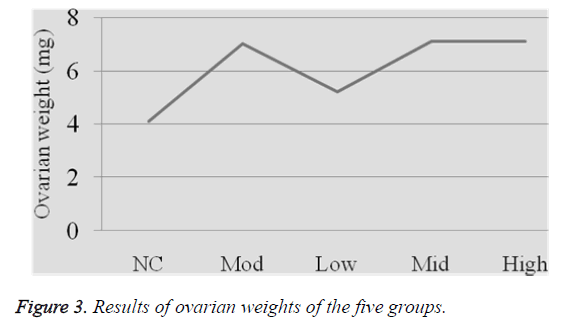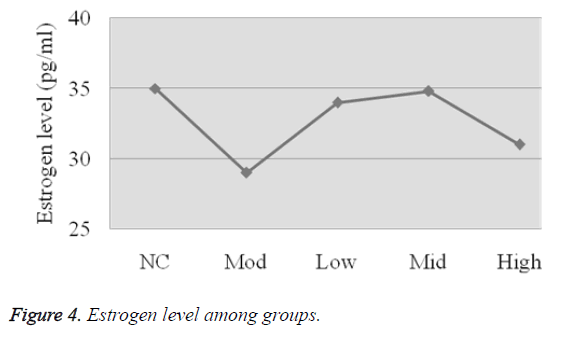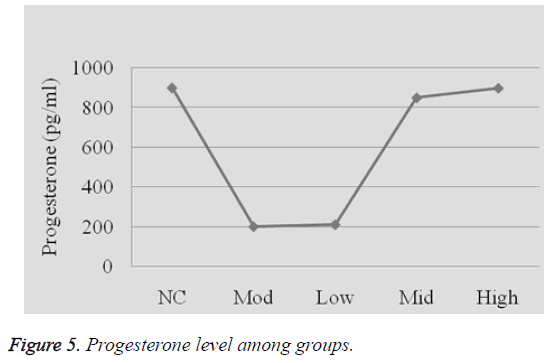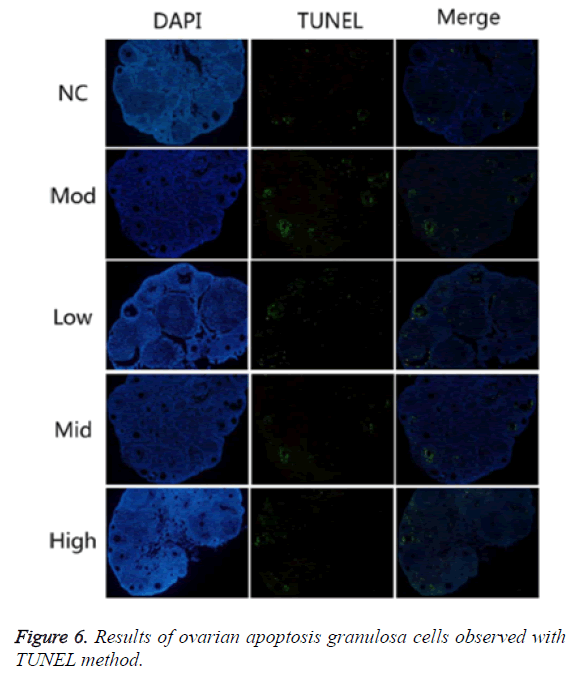ISSN: 0970-938X (Print) | 0976-1683 (Electronic)
Biomedical Research
An International Journal of Medical Sciences
Research Article - Biomedical Research (2017) Volume 28, Issue 21
Protective effects of Kuntai capsule on the rat ovarian function of frozen-thawed transfer
1The First Clinical Medical College, Shandong University of Traditional Chinese Medicine, Jinan, 250355, PR China
2Department of Gynecology, Affiliated Hospital of Shandong TCM University, Jinan, 250011, PR China
#These authors contributed equally
- *Corresponding Author:
- Zhang Jianwei
Department of Gynecology
Affiliated Hospital of Shandong TCM University, PR China
Accepted date: July 06, 2017
Objective: This paper investigated the effects of Kuntai capsule on rat ovarian function of frozen-thawed transfer.
Methods: 85 female C57BL/6 mice are selected for this study. 17 of the mice are marked as the Normal Control group (NC). The rest of 68 are selected to set a novel accelerated aging ovary model via superovulation then via randomly separating the mice into four equal groups. One group is marked as Model Group (Mod). Other three groups are intragastrically administered with high (1.5 g/kg), middle (1.0 g/kg) and low (0.5 g/kg) dosages of Kuntai capsule every day for 3 weeks. Ovarian function is appraised via sex hormone level experiments.
Results: Mod group clearly presents worse ovarian function comparing with the NC group. Some improvement is gained after Kuntai capsule treatment. Enzyme immunoassay for 17 β-estradiol (E2) and progesterone (P) have statistical significance.
Conclusions: This study created a new model for investigating the effects of Kuntai capsule on rat ovarian function of frozen-thawed transfer. These results suggest that superovulation may create a new model. More importantly, Kuntai capsule may regulate the anti-apoptosis pathway to protect the growing follicular quality, allowing recovery of the endocrine and reproductive ability of the aging ovary.
Keywords
Ovarian function, Kuntai capsule, Frozen-thawed transfer, Accelerated aging ovary.
Introduction
With the increase in women’s life-expectancy, a growing number of women will spend nearly 30% of their lives in a state of menopausal [1]. During menopause, the drastic decline of estrogen production can lead to a decrease in life quality, including various perimenopausal and post-menopausal symptoms and pathologies [2-4]. Thus, many women use hormone replacement therapy to relieve climacteric symptoms and ameliorate their life quality. However, increasingly more studies have challenged the safety of HRT, citing the risk of venous thromboembolism or coronary event, breast cancer, stroke and gallbladder disease [5].
HRT is the primary management of menopausal symptoms in Western medicine. However, the potential adverse effects drive the clinicians to actively seeking alternative therapies. Among the alternative treatments, Chinese medicine, such as Kuntai capsule, may give them a better solution and fruitful area [6]. Kuntai capsule, a TCM herbal formulation, has been highly applied to treat menopausal syndrome for a long time, which is a compound preparation of six Chinese herbs, prepared rhizome of Adhesive Rehmannia, Coptis Chinensis Franch, White Paeony Root, Scutellaria Baicalensis, Colla Corii Asini and Wolfiporia Cocos [7-12]. Recently, lots of trials in China have proved that Kuntai capsule has significant and positive effects in allaying menopausal symptoms in Chinese women [13-15].
This paper will establish a new ovarian aging acceleration model to induce a decline in both the quantity and quality of the oocytes and was designed to evaluate the effect of Kuntai capsule on damaged ovarian function and identify its possible mechanisms on menopausal syndrome.
Materials and Methods
Female F1 hybrid mice are obtained from female C57BL/6 and male CBA/Ca mice copulation under followed conditions: lighting (13 L: 10 D), temperature (19°C-23°C), and humidity (42%-61%). Pre-pubertal 2 week old F1 female mice are applied for recovery of the ovaries in this paper. Reasonable management of experimental samples and quality management, control of the laboratory equipment’s are made.
The ovaries gained from donor mice are sectioned for 0.7 to 0.8 × 0.2 to 0.3 × 0.1 mm in size and then are cryopreserved via a noval method of Gosden et al. [16]. Briefly, they were suspended in L-15 medium containing 10% (v:v) foetal bovine serum and 1.5 M DMSO on ice then placed individually into the middle of a 0.5 mL plastic straw using a small volume of medium.
After being sealed with straw powder, the straws were placed in a programmable freezer pre-cooled to 5°C for 35 min. The slow-freezing procedure was as follows: cooled at 1°C/min to -7°C and held for 6 min, seeded manually, held at -7°C for 12 min, and cooled to -30°C at 0.3°C/min. The straws were then exposed to liquid nitrogen vapour for 5 min and stored in liquid nitrogen for up to 3 min. To thaw, the straws were placed on a warm plate at 37°C for 30 sec and the ovaries were removed.
The cryoprotectant was removed by serial dilutions of the cryoprotectants with one or more washes in medium, which could avoid rapid osmotic processes in the cryopreserved tissue. After removing cryoprotectant, the thawed ovaries were washed repeatedly in L-15 medium containing 10% (v:v) FBS at 37°C before experimental treatment.
Kuntai capsule was provided by Guiyang XinTian Pharmaceutical Stock Limited Company (Guiyang, China). Kuntai capsule was diluted with distilled water to final contents of 40 mg/mL, 20 mg/mL and 10 mg/mL, respectively, and stored at 3°C before using.
The novel models with accelerated aging ovaries are randomly grouped into 4 groups (n=17 per group): the Model Control group (Mod) and the groups treated with low, middle and high doses of Kuntai capsule (Low, Mid and High). Kuntai capsule (Low, Mid and High) was intragastrically administered at a dosage of 1.5 g/kg, 1.0 g/kg and 0.5 g/kg per d, respectively, for 3 consecutive weeks. The Mod group was injected with the identical volume of physiological saline. Healthy mice with no treatment were considered to be the Normal Control group (NC).
Blood samples are gained from sterile, non-heparinized tubes from non-pregnant mice at diestrus of the estrous cycle. The blood samples are carried out for centrifugation at 3200 rpm for 4 min, and serum is gained and stored at -80°C until for analysis. Levels of serum enzyme immunoassay for 17 β- estradiol (E2) and progesterone (P) were measured by Enzyme- Linked Immune Sorbent Assay (ELISA) according to the manufacturer’s instructions (Cayman Chemical Company, Ann Arbor, USA).
Statistical analysis was conducted using SPSS 12.0 software. Differences in body weight, follicle count and hormones were analysed using a t-test or One-Way Analysis of Variance (ANOVA). P<0.05 was considered statistically significant.
Results
Effects of Kuntai capsule on body and ovarian weights
All of the mice were alive after treatment, and before treatment, there is no significant differences observed in body weight of the mice in various groups (P>0.05). During the treatment process, the NC group rapidly outweighed the Mod group (P<0.05), which is shown in Figure 1. The low (Kuntai capsule) group gained weight in a manner similar to the Mod group. However, the mid and high groups had body weights similar to the NC group after three week’s treatment (Figure 2).
There are no significant differences in organ weights observed among groups except for the weight of the ovaries. The gross ovarian weight of the Kuntai capsule groups was similar to the weights of the Mod group and higher than the weights of the NC group (Figure 3).
Effects of Kuntai capsule on sex hormone levels
A significant decrease was observed in the level of estradiol (E2) (P<0.05) and progesterone (P) (P<0.01) of the Mod group compared with the estradiol of the NC group, and the Mod group showed the lowest E2 level of all the groups.
There was no significant change in the P level between the Low (Kuntai capsule) and Mod (P>0.05) groups. However, compared with the Mod group, the P levels of the mid (P<0.05) and High P<0.01) groups increased significantly, similar to the NC group (Figures 4 and 5).
Effects of Kuntai capsule on granulosa cell apoptosis
The TUNEL assay easily distinguished between apoptosis granulose cells (TUNEL-positive cell) and others. Few TUNEL-positive cells are found in the NC group. By contrast, the number of TUNEL-positive cells is obviously increased in the Mod group. After Kuntai capsule administration, the percentage of TUNEL-positive cells was significantly lower than the percentage in the Mod grouping (Figure 6).
Discussion
As one of the most frequently used experimental animals, folliculogenesis in the mice is comparable to folliculogenesis in humans. Moreover, mice oocytes have radiation resistance comparable to that of humans, which provides a better model [17,18]. Therefore, the mouse is a useful animal model to study ovarian follicular development and oocyte maturation in relation to radiotoxicology. However, there are few reports about ovarian cryopreservation of this species [19].
The ovaries present an age faster comparing with other body systems, and ovarian age faster is characterized by gradual declines in quantity and quality of ovarian follicle [20-22]. In this study, both the primordial follicle pool and oocyte quality decreased significantly in the model mice, consistent with the characteristics of ovarian aging. Previous research revealed that the decrease in numbers of follicle indicates the onset of irregular cycle and the final stopped menstruating whereas the decline in follicle quality leads to the gradual deterioration of fertility. In this study, the Mod group displayed low hormone levels with the NC group. All of these results indicated that the Mod group displayed the ovarian aging phenomenon. As a part of the whole, accelerated aging of the ovaries will follow other organ aging and even present constitutional symptoms. In this study, Kuntai capsule treatment improved the body weight, indicating that Kuntai capsule may improve the symptoms caused by accelerated aging of the ovaries.
Ovarian function is primarily reflected in endocrine and reproductive functions. Current evidence suggests that late in the process of ovarian aging, the E2 level decrease relative to the process and the P level does not change significantly [23]. In this study, the Mod group showed a decrease in both E2 and P levels compared with the NC group. However, the Kuntai capsule groups more or less raised those levels.
Menopause results from ovarian aging, and the aging process of ovaries is characterized by a gradual decrease in both the quantity and quality of the oocytes [24]. According to some studies, the many primordial follicles formed during the development of an embryo inevitably decline as women age and drop below 1000 approaching menopause. In addition to the decrease in follicles, oocyte quality also diminishes with age. The results of daily metabolic processes, the metabolic products are supposed to be a primary cause of ovarian aging.
Kuntai capsule, reducing pathogenic fire, stabilizing the mind, eliminating worries and regulating Yin and Yang, which could effectively relieve menopausal symptoms. In recent decades, Kuntai capsule has been used in clinics for alleviating menopausal symptoms and has had no apparent estrogenicity for decades. Recent clinical investigations have also suggested that Kuntai capsule can effectively ameliorate low estrogen levels caused by the add-back therapy of gonadotropinreleasing hormone agonist for endometriosis.
More and more young women can survive with cancer because of the progress of medicine. Therefore, the main goal is to protect the reproductive potential of cancer patients before treatment-induced infertility [25]. Currently, not only older women suffer from ovarian aging; many young women are also being diagnosed with Premature Ovarian Failure (POF), frequently expressed as vexation, insomnia and possible sterility. Therefore, it would be a significant benefit to identify an effective manner with which to ameliorate the symptoms of ovarian aging. This study indicated that Kuntai capsule may have beneficial effects on accelerated aging of the ovaries, which leads to various health consequences, including mood disorders, vasomotor symptoms, cardiovascular disease, osteoporosis, sexual function, cognition, depression, and vaginal atrophy.
Conclusions
Kuntai capsule has been used in treating perimenopausal syndrome and polycystic ovary syndrome for lots of years. This study created a new model for rat ovarian function of frozen-thawed transfer based on the findings that the primary factors in menopause are ovarian aging and the decline in both the quantity and quality of the oocytes. These results suggest that Kuntai capsule may recover the endocrine and reproductive ability of the aging ovary.
References
- Hauck K, Martin S, Smith PC. Priorities for action on the social determinants of health: Empirical evidence on the strongest associations with life expectancy in 54 low-income countries, 1990-2012. Social Sci Med 2016; 167: 88-98.
- Rossella EN, Martire P, Nicoletta B, Angelo C, Costantino DC, Stefano L, Anna MP. Attitudes and perceptions towards vulvar and vaginal atrophy in Italian post-menopausal women: Evidence from the European REVIVE survey. Maturitas 2016; 91: 74-80.
- Shaochen G, Zhe T, Xianghua F, Xiaoguang W, Hongjun L, Chunxiu W, Chengbei H. Prevalence of hyperuricemia among Beijing post-menopausal women in 10 years. Arch Gerontol Geriat 2016; 64: 162-166.
- Biju B, Mridula AB, Myint S, Sandheep S. Review on the comparison of effectiveness between denosumab and bisphosphonates in post-menopausal osteoporosis. Osteop Sarcop 2016; 2: 77-81.
- Markström E, Svensson E, Shao R. Survival factors regulating ovarian apoptosis-dependence on follicle differentiation. Reprod 2002; 123: 23-30.
- Kyungdo H, Youngkyung K, Yong-GP, Jun-BP. Associations between the number of natural teeth in postmenopausal women and hormone replacement therapy. Maturitas 2016; 94: 125-130.
- Quan Z, Jing T, Huamei S, Aihua C, Huaijie Y, Manzhen Z, Hairong L. Chinese herbal medicine Kuntai capsule for treatment of menopausal syndrome: a systematic review of randomized clinical trials. Complementary Therap Med 2016; 29: 63-71.
- Li CC, Wang JJ, Chen C. Treating menopause syndrome by kuntal capsule and hormone replacement therapy: a meta-analysis of efficacy and safety comparison. Chin J Integr Tradit Western Med 2013; 33: 1183-1190.
- Yin BJ, Niu HJ, Jin RL. The impact on Kuntai capsule and tibolone on improving quality of life in postmenopausal women. World Health Dig 2013; 52: 33.
- Yang Y. Clinical efficacy of Kuntai capsule for menopausal syndrome. Tanjin Pharma 2010; 22: 34-35.
- Wang SH, Lin SQ, Jin MJ, Gui QF, Chen FL. Efficacies of different low-dose regimens of hormone therapy in postmenopausal women. Chin J Pract Gynecol Obstet 2007; 23: 184-188.
- Luan YQ, Yang X, Peng XL, Fu C, Meng ZX, Zhang J. Double-blind double-dummy randomized parallel clinical trial of Kun-tai capsule in the treatment of perimenopausal symptoms. Chin J Clin Pharmacol 2004; 20: 452-455.
- Re ZWGL. Efficacy and safety of Kuntai capsule and estradiol valerate for menopausal syndrome. Chin Foreign Women’s Health 2014; 3: 88.
- Shen HJ. Kuntai capsule for treatment of menopausal syndrome: a retrospective analysis of 86 cases. Med Inf 2011; 24: 6091-6092.
- Tang LL, Xu LZ, Liu HW. The impact on Kuntai capsule and premarin on improving early menopause symptoms and cardiovascular risk factors. J Sichuan Univ 2010; 41: 366-369.
- Kim GA, Kim HY, Kim JW, Lee G, Lee E, Ahn JY, Park JH, Lim JM. Effectiveness of slow freezing and vitrification for long-term preservation of mouse ovarian tissue. Theriogenol 2001; 75: 1045-1051.
- Candy CJ, Wood MJ, Whittingham DG. Restoration of a normal reproductive lifespan after grafting of cryopreserved mouse ovaries. Hum Reprod 2000; 15: 1300-1304.
- Bagis H, Akkoc T, Tass A, Aktoprakligil D. Cryogenic effect of antifreeze protein on transgenic mouse ovaries and the production of live offspring by orthotopic transplantation of cryopreserved mouse ovaries. Mol Reprod Dev 2008; 75: 608-613.
- Chen SU, Chien CL, Wu MY, Chen TH, Lai SM, Lin CW. Novel direct cover vitrification for cryopreservation of ovarian tissues increases follicle viability and pregnancy capability in mice. Hum Reprod 2006; 21: 2794-2800.
- Younis JS. Ovarian aging and implications for fertility female health. Minerva Endocrinol 2012; 37: 41-57.
- Broekmans FJ, Soules MR, Fauser BC. Ovarian aging: mechanisms and clinical consequences. Endocr Rev 2009; 30: 465-493.
- Soules MR, Sherman S, Parrott E. Executive summary: stages of reproductive aging workshop (STRAW). Climacteric 2001; 267-272.
- Muttukrishna S, Child T, Lockwood GM. Serum concentrations of dimeric inhibins, activin A, gonadotrophins and ovarian steroids during the menstrual cycle in older women. Hum Reprod 2000; 15: 549-556.
- Das S, Chattopadhyay R, Ghosh S. Reactive oxygen species level in follicular fluid–embryo quality marker in IVF? Hum Reprod 2006; 21: 2403-2407.
- Jinjin Z, Li F, Liangyan S, Zhiwen L, Zhiyong L , Jiaqiang X, Meng W, Aiyue L, Shixuan W. Protective effects and mechanisms investigation of Kuntai capsule on the ovarian function of a novel model with accelerated aging ovaries. J Ethnopharmacol 2017; 195: 173-181.
